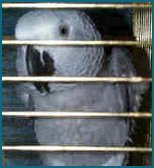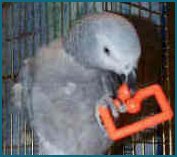|
Leena came from a customer whom I had been helping for several months to deal with behavioral problems between her and the rest of the family. Her wings had been severely clipped, as a baby, and she had never learned to fly. It also affected her balance, so she fell a lot. She became phobic and began plucking her feathers out. Her former owner was worried about her health and happiness, and didn't want to see her upset for the next 50 years, so he called me.


I knew she had never been to a vet, so the first thing I did was take her to the only Avian Certified Vet in the area. I wanted to make sure there were no physical reasons she might be plucking. Birds can get several diseases and nutrition plays a big part in how they feel. We ran the most comprehensive test we could. She came back healthy and disease-free, but a little under weight and malnourished. I took her home and set up her new cage. She met the non-feathered members of the family and we let her have some quiet time to settle into her new home. It took about two weeks for the results to come back, so, due to the fact that I have other birds, Leena remained in Quarantine until we knew she was healthy.
Some Diseases Known to Contribute to Feather Plucking ...
- Psitticine Beak and Feather Disease
- Guiardia
- Yeast, Fungal, and Bacterial infections
- Malnutrition
Some Factors of Phobia ...
- Cage is too small, insecure, too high, misplaced in a room, or crowded.
- Toys are the wrong size, not enough or too many, wrong kind for the personality of the bird.
- Perches are not set for the comfort of the bird. Need different sizes for proper foot health.
- Improper handling: Yelling, screaming, rushing at the bird. Threatening hand jestures. Insecure perching.
- Fearing the bird's beak or talons.
- Inconsistant behavior: Ignoring the bird, irregular feeding habits.
Quarantine Procedures ...
- Should last two months, or until certified health certificate is obtained. Remember, some diseases can't be tested for.
- Keep new bird away from established birds. No physical contact. Follow strict anti-cross-contamination procedures. Should be kept in an area where air, water and food are not in contact with other birds.
- Keep an eye on their droppings, weight, eating habits, and general behavior. These are the key to noticing if the bird has any health problems.
- Remember, even though the new bird is in isolation, they still need daily interaction with you. Play with them and make sure they are as comfortable as possible.


After she came home, I had to find out why she had turned from a sweet, cuddly baby into a combative, phobic, biting, toddler. I started with the obvious environmental problems from her last home. It boiled down to her feeling insecure, at worst, and bored, at best. I covered the sides and back of her cage with a beach towel to limit the amount of stimuli coming at her. This helped her realize her cage was a safe haven. I lowered it so she wasn't the highest thing in the room. That way, if she fell, it wouldn't be far. I added toys that were the right size for her and made sure that they were no higher than eye level, when I could. I gave her Talon Toys, something she'd never had, before. The perches were raised to force her to perch and different sizes were added to keep her feet healthy. She started eating healthy human foods, in addition to the seed she had always had, and her food dishes were placed off the floor of the cage, for better access. I encouraged the other family members to lay with her, at set times of the day, so she'd learn a routine. I started giving her baths to improve the feathers she still had and encourage her to leave any new ones that grew in.
Continued Next Page ...
|

